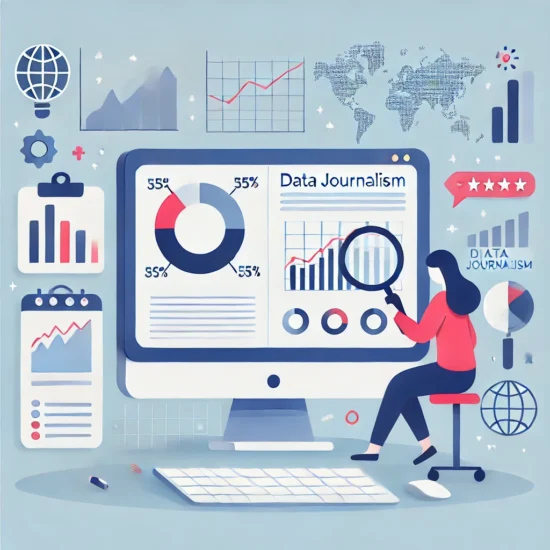Opportunities and Challenges in Data Journalism – Data journalism, a pivotal player in the digital revolution, is redefining the narrative landscape. With newsrooms tapping into vast data reserves to unearth truths and communicate complex ideas, the need for proficient data journalists has never been more pronounced.
These professionals, blending traditional journalism with data technology, offer deeper insights into stories that matter—politics, public health, environmental issues, or historical events. The evolution of data-driven journalism has opened up many opportunities for data analysts and storytellers.
However, it also presents distinct challenges, from navigating the ethical complexities of data representation to mastering the technical skills required. This new terrain demands statistical and programming expertise, coupled with a strong journalistic instinct, to identify and craft compelling narratives from raw data.
In this exploration of information journalism, we delve into the expanding roles available to record reporters, the vital capabilities that underpin their work, and the persistent challenges they face in this dynamic area.
As facts keep gliding greater freely in our information-wealthy global, facts newshounds play an essential role in ensuring that these statistics serve the public correctly, turning numbers into narratives that spark speak and force change.
Whether running in bustling newsrooms, contributing to think tanks, or freelancing across virtual platforms, records journalists are reshaping the bounds of journalism and public engagement.
What is Data Journalism?
Data journalism represents a confluence of numerous disciplines, merging investigative journalism, statistical analysis, and statistics visualization to craft testimonies driven using statistics.
Unlike conventional journalism predicated on verbal or written sources, records journalism includes poring over large datasets to discover styles, anomalies, and correlations that won’t be visible to the naked eye.
This exercise permits reporters to utilize data as a supply of statistics on par with human sources, offering a strong basis for memories requiring deep, evidence-based evaluation. The system typically includes collecting statistics and studying them through statistical gear, after which imparting it in a form that is both on hand and attractive to the public.
This could imply interactive maps, infographics, or complex data visualizations that assist in conveying complex statistics clearly and visibly. Data journalism not only bolsters the credibility of a story with quantitative evidence but also offers a fresh perspective to narrative storytelling.
By unveiling compelling trends and insights, this approach has significantly influenced reporting on topics like government spending, crime patterns, healthcare inefficiencies, and more. In these areas, where the sheer volume of data can be overwhelming, data journalism provides a revealing lens.

The Growing Demand for Data Journalists
As the role of data in our society expands, so does the need for data journalists who can interpret and report these facts effectively. The demand for these specialists is evident across numerous sectors, not just in traditional media but also in non-traditional information-collecting groups.
Where the ability to analyze and derive meaningful insights from data can set a story apart. This surge is fueled by the increasing popularity of data-driven stories that can attract readership and engagement levels that traditional stories might not.
Media retailers are increasingly seeking newshounds who aren’t only adept at conventional reporting competencies but also talented in statistics analysis, programming, and visible storytelling.
Integrating information journalism into mainstream media has brought about greater nuanced and knowledgeable reporting, especially on complex problems, elections, public spending, and social justice, where readers gain deeper expertise of the underlying facts.
This shift toward a more analytical news lifestyle has also prompted instructional institutions to introduce specialized guides focusing on the intersection of data technological know-how and journalism.
Graduates from these applications are getting into the body of workers with excessive talent called for, promising a colorful, professional landscape.
However, the growth of statistics journalism also challenges newsrooms to conform their workflows and infrastructure to assist records-heavy reporting, ensuring that those memories aren’t simplest insightful but additionally accurate and ethically sound.
As this field continues to adapt, the function of fact reporters might be critical in shaping a more knowledgeable and engaged public.
Educational Pathways and Skills Required
As information journalism continues to carve out an enormous niche in the media panorama, academic pathways and the talents required for this field have become increasingly crucial.
Aspiring data journalists must combine traditional journalistic competencies with a stable foundation in records and technological know-how to navigate and elucidate the sizable datasets that underpin the latest investigative tales.
Universities and faculties have replied to this call by integrating facts evaluation, statistical methods, and virtual storytelling into their journalism curricula. Specialized degrees are more common, imparting courses that delve into software programming, information visualization, and the moral dimensions of digital journalism.
These packages are designed to beautify students’ narrative capabilities and offer them the technical know-how vital for managing complicated records units. To thrive in facts journalism, one must own a variety of capabilities:
Analytical capabilities are crucial for deciphering massive volumes of records and extracting meaningful insights. Technical prowess in programming languages like Python or R is essential for facts adaptation, while equipment including Tableau or Adobe Illustrator is vitaliser growing impactful visualizations.
Core journalistic competencies remain fundamental, as the capacity to craft a compelling tale, uphold ethical standards, and behave through investigative work is essential.
Critical thinking is needed to evaluate the credibility of statistics sources and discover underreported or hidden memories. This fusion of journalism and data science skills makes data journalists particularly valuable in today’s media environment.
They ensure that storytelling is not only informative but also grounded in verifiable data. As technology advances, the role of data journalists becomes even more critical in informing the public and shaping discourse on crucial issues.

Opportunities in Data Journalism
The increasing discipline of records journalism gives quite a few professional opportunities catering to various interests and capabilities. Data journalists are not restricted to conventional newsrooms.
They’re increasingly more in demand throughout virtual structures, public family members, advertising organizations, and even in policy-making bodies wherein their capability to dissect and present complex statistics units can affect choice-making and public opinion.
In media retailers, information reporters carry a new intensity to reporting, particularly in regions that include investigative journalism, election insurance, and public interest stories.
Their capacity to unearth and make clear connections inside massive volumes of records can result in impactful memories that might move untold in any other case. This function is crucial in a technology where record breaches, incorrect information, and complicated governmental guidelines are common.
Beyond journalism, information specialists can find roles in strategic communication sectors, assisting manufacturers and businesses to recognize and speak with their target audiences extra effectively.
Information visualization and analysis abilities are also prized in content material marketing, enhancing the ability to craft statistics-pushed campaigns that resonate with purchasers. Furthermore, academic and research institutions also recognize the value of facts journalism.
Researchers and educators are leveraging those abilities to research media developments, manual journalistic integrity, and train the following era of reporters, ensuring that the sphere keeps adapting and adapting to new technology and challenges.
These various opportunities spotlight the dynamic nature of records journalism as a career—one that now not handiest informs public debate but additionally shapes how statistics is supplied and fed on within the virtual age.
Conclusion
Records journalism has emerged as an important tool in the quest for reality and transparency in the short-evolving media panorama. As this field prospers, it gives each exciting opportunities and ambitious challenges, ensuring its practitioners are at the forefront of the digital revolution in journalism.
This new news conventional reporting competency with advanced data evaluation is increasingly vital in uncovering and crafting tales that resonate deeply with audiences. Their paintings, underpinned with a rigorous utility of information technological know-how, give insights into complex problems that would otherwise continue to be obscured or misunderstood.
The shift closer to information-pushed journalism requires a mix of competencies not restrained to superior statistical analysis, talented programming for records processing, and a sturdy narrative experience to convert numbers into enticing stories.
Educational institutions are stepping up, presenting tailor-made publications that equip the following era of newshounds with the vital tools to navigate this complex area. As facts flow greater freely and abundantly, the responsibility on records reporters grows, making their function pivotal in shaping knowledgeable public discourse.
However, the path is not without its hurdles. Ethical challenges, which include ensuring data privacy and warding off misrepresentation, together with the technical demands of the activity, hold to test even the maximum seasoned journalists. Despite those demanding situations, the possibilities for effect and innovation in statistics journalism are sizeable.
Whether influencing policy choices, riding social trade, or enlightening the general public, information reporters have a critical role in our digital society. As they continue to push the bounds of journalism, they now not only debate about what it means to be a journalist inside twenty-twenty-firstry.
FAQs on Data Journalism
What is data journalism?
Data journalism is a journalistic system that includes accumulating, studying, and visualizing huge datasets to uncover and tell memories. It blends conventional journalism with records evaluation and technological tools to offer deeper insights into complicated troubles.
Why is data journalism important?
Data journalism is important as it lets newshounds deal with the substantial amounts of information available in our virtual age to discover truths that cannot be discovered through conventional journalism on my own. This approach complements transparency, affords strong proof for memories, and helps fight incorrect information.
How can I start a career in data journalism?
Starting a profession in statistics journalism typically includes gaining the necessary skills through education and exercise. This may be via journalism tiers offering information journalism tracks, devoted data journalism applications, or self-observed relevant equipment and strategies. Gaining revel in thru internships or contributing to facts journalism initiatives also can be beneficial.
What are the typical challenges a data journalist faces?
Challenges in statistics journalism consist of navigating ethical considerations around facts privacy, ensuring the accuracy of records interpretations, accessing constrained or complex statistics, and being persistent in getting to know to keep up with evolving technology and methodologies.
Where do data journalists typically work?
Data journalists work in diverse environments, such as conventional newsrooms, online media retailers, research establishments, and freelance positions. They might also locate roles as public members of the family, in corporate communications, or as facts analysts in non-media organizations that value storytelling through facts.
What impact has data journalism had on the media industry?
Data journalism has notably impacted the media industry by raising the analytical depth of reporting and improving target market engagement through interactive tales and visualizations. It has also multiplied duty in public affairs by making complicated facts greater on hand and understandable to the overall public.
Can data journalism be biased?
How is impartiality maintained? Like all styles of journalism, data journalism can be liable to bias in how facts are selected, analyzed, or provided. To keep impartiality, statistics reporters must adhere to rigorous standards of accuracy, offer context for their records, use obvious methodologies, and reveal any ability biases in their statistics sources.
Read Here: What is Multimedia Journalism?


